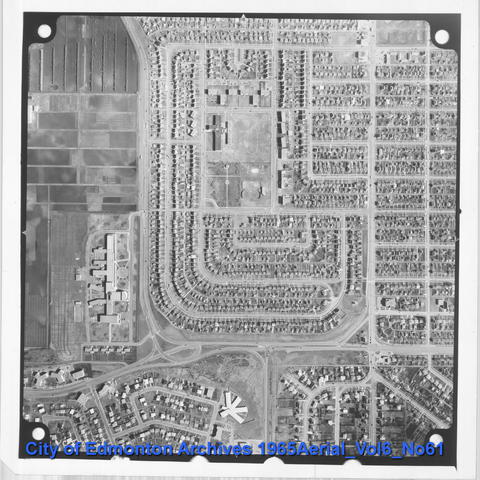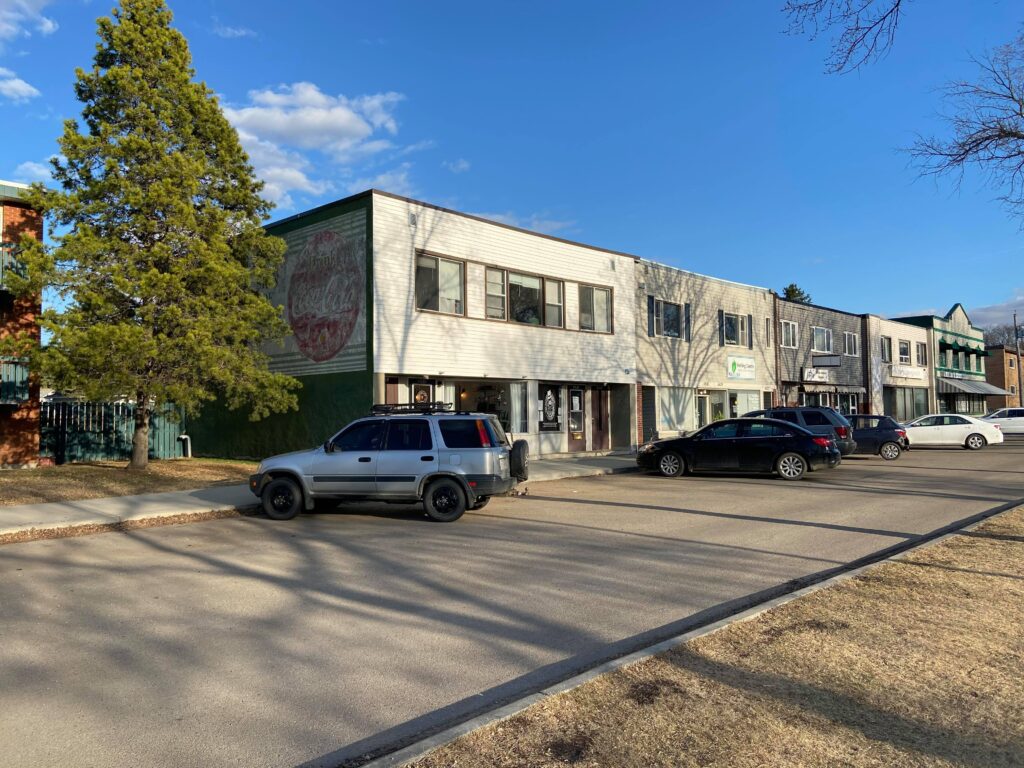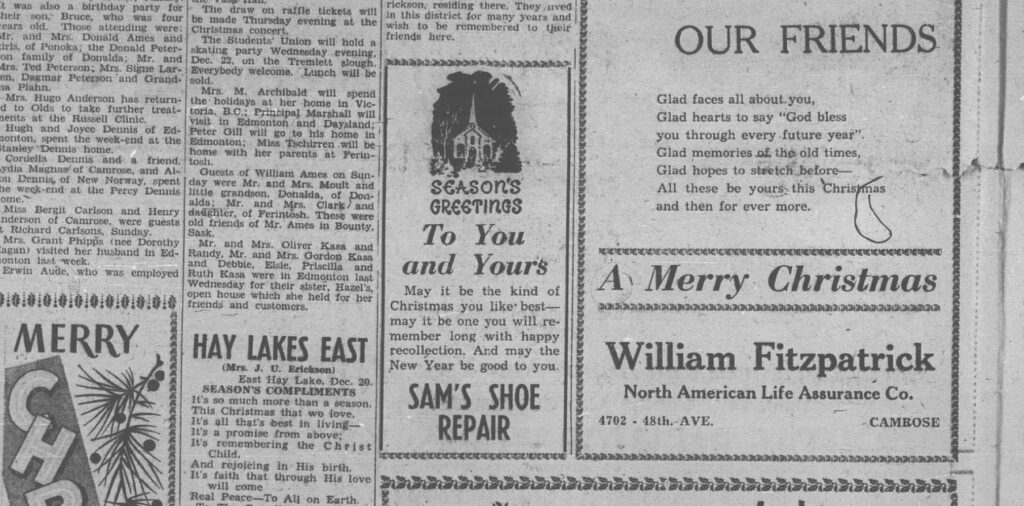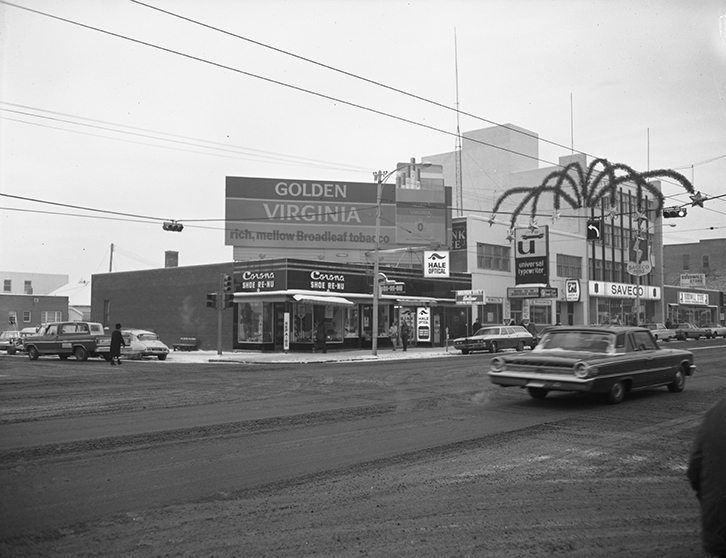It was the turbulent sixties. In the United States and Canada, teenage unrest was making headlines. Even in the small city of Edmonton, the youth were restless and looking for change. The high school students at Scona would gather after school at the pizza shops under clouds of cigarette smoke, arguing that the Americans should get out of Vietnam, and that the student dress code should be relaxed enough to allow them to wear blue jeans. My dad, uninterested in breathing in the smoke or in wearing blue jeans, found himself looking for a different sort of atmosphere to spend his time. He found it at the shop of Sam the Shoemaker in Parkallen.
Sam’s Shoe Repair drew a different sort of crowd. Nestled among window displays of quality boots and Mexican art were the shop’s customer chairs, frequently filled by neighbourhood residents wanting to complain about the impact of the elder Trudeau’s policies on Edmonton, or to pass the time with a game of cards, or to shoot the breeze about the goings-on in the neighbourhood and in the swiftly changing world. Sam would eagerly set aside his current repair project for a game of crib, or even a game of horseshoes in the park across the street—work could always be completed in the mornings when the neighbourhood was quiet, but when everyone was popping in and out, he was as ready as any of them to liven up the day.
My dad would perch on a chair further in at the ripping table, giving Sam a hand by prying old soles off the work boots brought in for repair. He was the kind of kid who was drawn to exploring, and he would get to know all the shops and buildings around Edmonton, including ones he wasn’t encouraged to explore too well, like the imposing Hotel MacDonald. But Sam didn’t mind a teen hanging around his shop looking for something new to discover during the leisure times when my dad wasn’t busy with school or paper route or chores. Sam could also tell my dad’s mind was fascinated by how things were put together.

My dad had been first drawn to the shop by the astounding array of leathers—more kinds than he had ever dreamed existed—and various types of leather fastenings. Shoes didn’t appear fully formed, out of thin air, but could be pieced together and then maintained to last years and years. He absorbed all he could about shoemaking—Sam knew the art of both shoemaking and shoe repair, and he had a reputation for quality. There was no better place to get an insight into the trade. And there was no better place to stay up to date on the news, whether it was the story of how the safe from Parkallen Drugs had been stolen and left in Clover Bar with its bottom knocked out,[1] or a story about how the Beatles’ latest release was taking over the charts.
“Sam was tall with a fringe of hair around his head,” my dad says. “And he always wore sandals—funny for a shoemaker, eh? Even in the winter. He’d park his car close to the door and rush into the shop.”
Sam let my dad explore the shop and get to know all the machines. Sam knew exactly what was needed for each job, and what kind of equipment could punch through thick leather without breaking to produce the results he wanted. The small shop was laid out simply. On the north wall were the grinders and buffers which could shape the leather and smooth it. In the middle was the sewing machine, which stitched the shoe uppers to the soles. The south wall held a small table and chair where the ripping was done —my dad would sit here and bend his blond head over the boots as he ripped, setting them aside for Sam to sew on replacement soles. Sam would also periodically let my dad try out the sewing machine, allowing him to carefully stitch even lines in the leather.
As the parts of the shoes came together, the little community of the shoemaker’s shop would gather too: Ray, from the drugstore in the centre of the strip, and the old-timers who were looking to play another game of cards, and the neighbours who just needed a friendly face to chat with.

Aerial map of the Parkallen neighbourhood, 1965. Image courtesy of the City of Edmonton Archives, 1965Aerial_Vol6_No61_141.
People would gather at the shop because of Sam, but also because the shop was conveniently centred in the middle of the community. The neighbourhood of Parkallen was still somewhat new in the 1960s, having been established in the 1950s, and it was an experimental concept for Edmonton. Instead of being laid out on a grid, it was designed in a series of curving streets centred around a park and a commercial strip. Both the park and the stores were meant to be a hub for the community, and for a time all a person really needed was within walking distance in the neighbourhood. This strip contained more than one grocery store, a service station to fill up or fix your car, a drugstore, a hairdresser, and, of course, a shoemaker to repair your weathered and salt-stained shoes. The bus used to stop at the end of the road from the strip, and weary commuters would walk up past these businesses, peering in the wide display windows to see what was new.
In the beginning, the barber shop had been a gathering place for the neighbourhood, but when it closed everyone moved on to the shoemaker’s instead. As the initial enthusiasm for building the new community wore off, and community interest and involvement among the residents became harder to stir up,[2] the businesses saw the benefit of being a draw for both residents and those outside the community to gather. It was a challenge to attract enough customers from within the neighbourhood itself, and their location inside a community made it harder for drivers on major transportation routes to find them. The stores that survived managed to draw customers from afar through word-of-mouth, and this included Sam’s shop.
Sam had been born in 1907 in Gorlicach, Poland, where he honed his skills in leatherwork and shoe repair. Initially he landed in Camrose, but when his children were old enough for university, he relocated his business to the neighbourhood of Parkallen. It wasn’t long until his reputation for quality work brought in customers from all over Edmonton, including my grandparents. Proper footwear was a necessity for the harsh winters, and a shoemaker who could make your footwear last would stretch the tight paycheques a little farther.

Sam took care of more than just the work boots whose heels my dad struggled to pry off. The children of the neighbourhood would cross from the rink in the park to get Sam to sharpen their skates or repair their hockey equipment.Belts would also come with only about three holes each, and so everyone went to the shoemaker to get a new hole punched in the exact right place for their waists. Later, when belts began to be manufactured with more than three holes, my dad noted it was one of those little changes that impacted the jobs of many local business owners.
My dad found the shoe repair trade fascinating enough that he might have considered it as a career, except even then the trade was on a decline. Synthetic shoes that were not as easily repaired were becoming popular, and people tended to buy new shoes instead of repairing their old ones.[3] Sam did well enough, but he could see the changes coming, and he made sure my dad understood. And my dad took the advice and went to study drafting at NAIT instead, learning how buildings were put together rather shoes. The rushing changes of the world were having an impact even in Parkallen.

An advertisement for Sam’s Shoe Repair from a Camrose newspaper. Image provided by the author.
The world changed and the number of shoemakers dwindled. Early residents of Parkallen moved away or passed away, and new families moved in. Sam retired around 1980 and sold the business to Earl Lawrence, who continued to operate Sam’s Shoe Repair for fifteen more years. Around 1995, Lawrence also sold the business, and after the sale an Edmonton Journal article from 1996 reports that the shoemaker who bought it still had many of the essential tools of the trade: “There’s burnishing ink, a heel nailer, shoe stretchers, an eyelet clincher, a treadle-operated sewing machine, a skiver, an iron foot, a selection of lasts, buffers, sanders and grinders, and a big electric sole stitcher made by the Landis company of St. Louis that waxes the thread to create a watertight seal.”[4] But there hasn’t been a shoemaker in the shop since that time—rather, it’s housed a variety of different businesses such as a bookshop, a flower shop, an artist studio, and now a coffeeshop. These local businesses continue to draw customers from all over the city.

The shoemaker’s tools are long gone, but the little strip of stores across from the neighbourhood park continues to be a community gathering place to this day. Frequent trips are made from the leafy green of the park to the coffeeshop or the nearby bakery for sustenance. And as for my dad, he stayed in Parkallen his whole life. He still tends his yards in his retirement, and chats to the neighbours. Communities in our hectic modern world still struggle to build strong ties between neighbours, but here the neighbourhood layout still brings to mind the tight-knit community feel of the early days of Parkallen. In this way, the little Parkallen commercial centre carries on the tradition of community-building that once centred in the leather-scented shop of Sam the Shoemaker.
Harma-Mae Smit © 2021
[1] “Police Court: 2 Drunken Drivers Given Terms in Jail,” Edmonton Journal, August 19, 1960, Newspapers.com.
[2] “Lack of Interest Felt in Parkallen,” Edmonton Journal, June 10, 1968, Newspapers.com.
[3] See “Corona Shoe Re-Nu exits after 82 years: New Footwear Trends Hurt Family Business” for more description of how the shoe repair trade declined in Edmonton over the years. (David Howell, Edmonton Journal, July 3, 2014, ProQuest Historical Newspapers.)
[4] Ric Dolphin, “Caribbean Cobbler now Edmonton’s Top Jamaican Sole Man,” Edmonton Journal, September 30, 1996, Newspapers.com.

